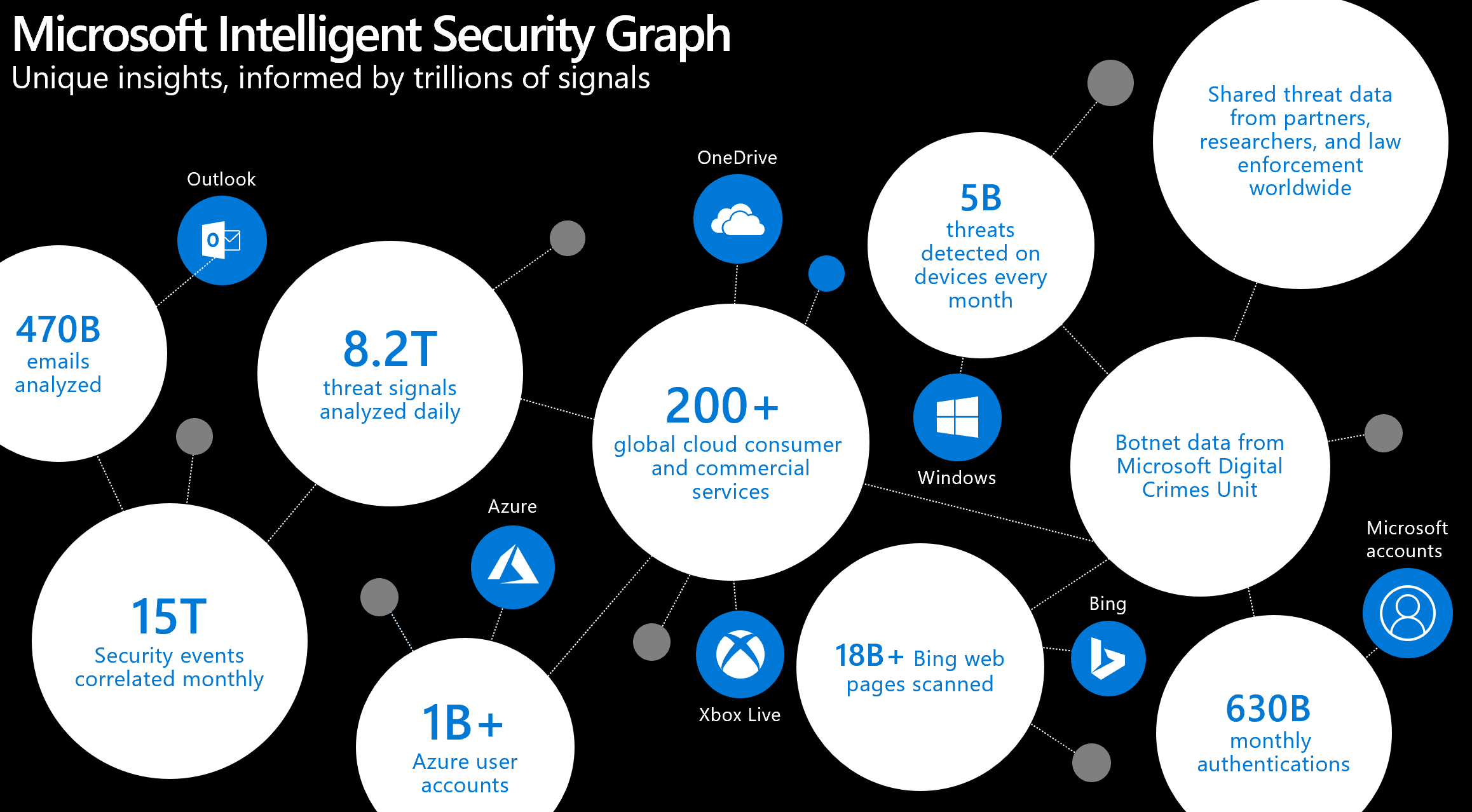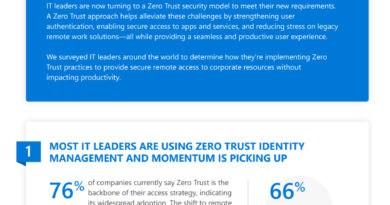Further enhancing security from Microsoft, not just for Microsoft
Legacy infrastructure. Bolted-on security solutions. Application sprawl. Multi-cloud environments. Company data stored across devices and apps. IT and security resource constraints. Uncertainty of where and when the next attack or leak will come, including from the inside. These are just a few of the things that keep our customers up at night.
When security is only as strong as your weakest link and your environments continue to expand, there’s little room for error. The challenge is real: in this incredibly complex world, you must prevent every attack, every time. Attackers must only land their exploit once. They have the upper hand. To get that control back, we must pair the power of your defenders and human intuition with artificial intelligence (AI) and machine learning that help cut through the noise, prioritize the work, and help you protect, detect, and respond smarter and faster.
Microsoft Threat Protection brings this level of control and security to the modern workplace by analyzing signal intelligence across identities, endpoints, data, cloud applications, and infrastructure.
Today, at the Microsoft Ignite Conference in Orlando, Florida, I’m thrilled to share the significant progress we’re making on delivering endpoint security from Microsoft, not just for Microsoft. The Microsoft Intelligent Security Association (MISA), formed just last year, has already grown to more than 80 members and climbing! These partnerships along with the invaluable feedback we get from our customers have positioned us as leaders in recent analyst reports, including Gartner’s Endpoint Protection Platform Magic Quadrant, Gartner’s Cloud Access Security Broker (CASB) Magic Quadrant and Forrester’s Endpoint Security Suites Wave and more.
As we continue to focus on delivering security innovation for our customers, we are:
- Reducing the noise with Azure Sentinel—Generally available now, our cloud-native SIEM, Azure Sentinel, enables customers to proactively hunt for threats using the latest queries, see connections between threats with the investigation graph, and automate incident remediation with playbooks.
- Discovering and controlling Shadow IT with Microsoft Cloud App Security and Microsoft Defender Advanced Threat Protection (ATP)—With a single click, you can discover cloud apps, detect and block risky apps, and coach users.
- Enhancing hardware security with our partners—We worked across our partner ecosystem to offer stronger protections built into hardware with Secured-core PCs, available now and this holiday season.
- Offering Application Guard container protection, coming to Office 365—In limited preview now, we will extend the same protections available in Edge today to Office 365.
- Building automation into Office 365 Advanced Threat Protection for more proactive protection and increased visibility into the email attacker kill chain—We’re giving SecOps teams increased visibility into the attacker kill chain to better stop the spread of attacks by amplifying your ability to detect breaches through new enhanced compromise detection and response in Office 365 ATP, in public preview now. And later this year, we’re adding campaign views to allow security teams to see the full phish campaign and derive key insights for further protection and hunting.
- Getting a little help from your friends—Sometimes you need another set of eyes, sometimes you need more advanced investigators. Available now, with the new experts on demand service, you can extend the capabilities of your security operations center (SOC) with additional help through Microsoft Defender ATP.
- Improving your Secure Score—Back up the strength of your team with numbers. New enhancements in Secure Score will make it easier for you to understand, benchmark, and track your progress. We also added new planning capabilities that help you set goals and predict score improvements, and new CISO Metrics & Trends reports that show the impact your work is having on the health of your organization in real-time.
- Taking another step in cross-platform protection—This month, we’re expanding our promise to offer protections beyond Windows with Enterprise Detection and Response for Apple Macs and Threat and Vulnerability Management for servers.
There’s no way one person, or even one team, no matter how large could tackle this volume of alerts on a daily basis. The Microsoft Intelligent Security Graph, the foundation for our security solutions, processes 8.2 trillion signals every day. We ground our solutions in this intelligence and build in protections through automation that’s delivered through our cloud-powered solutions, evolving as the threat landscape does. Only this combination will enable us to take back control and deliver on a Zero Trust network with more intelligent proactive protection.
Here’s a bit more about some of the solutions shared above:
Discovering and controlling cloud apps natively on your endpoints
As the volume of cloud applications continues to grow, security and IT departments need more visibility and control to prevent Shadow IT. At last year’s Ignite, we announced the native integration of Microsoft Cloud App Security and Microsoft Defender ATP, which enables our Cloud Access Security Broker (CASB) to leverage the traffic information collected by the endpoint, regardless of the network from which users are accessing their cloud apps. This seamless integration gives security admins a complete view of cloud application and services usage in their organization.
At this year’s Ignite, we’re extending this capability, now in preview, with native access controls based on Microsoft Defender ATP network protection that allows you to block access to risky and non-complaint cloud apps. We also added the ability to coach users who attempt to access restricted apps and provide guidance on how to use cloud apps securely.
Building stronger protections starting with hardware
As we continue to build in stronger protections at the operating system level, we’ve seen attackers shift their techniques to focus on firmware—a near 5x increase in the last three years. That’s why we worked across our vast silicon and first- and third-party PC manufacturing partner ecosystem to build in stronger protections at the hardware level in what we call Secured-core PCs to protect against these kind of targeted attacks. Secured-core PCs combine identity, virtualization, operating system, hardware, and firmware protection to add another layer of security underneath the operating system.
Application Guard container protections coming to Office 365
Secured-core PCs deliver on the Zero Trust model, and we want to further build on those concepts of isolation and minimizing trust. That’s why I’m thrilled to share that the same hardware-level containerization we brought to the browser with Application Guard integrated with Microsoft Edge will be available for Office 365.
This year at Ignite, we are providing an early view of Application Guard capabilities integrated with Office 365 ProPlus. You will be able to open an untrusted Word, Excel, or PowerPoint file in a virtualized container. View, print, edit, and save changes to untrusted Office documents—all while benefiting from that same hardware-level security. If the untrusted file is malicious, the attack is contained and the host machine untouched. A new container is created every time you log in, providing a clean start as well as peace of mind.
When you want to consider the document “trusted,” files are automatically checked against the Microsoft Defender ATP threat cloud before they’re released. This integration with Microsoft Defender ATP provides admins with advanced visibility and response capabilities—providing alerts, logs, confirmation the attack was contained, and visibility into similar threats across the enterprise. To learn more or participate, see the Limited Preview Sign Up.
Automation and impact analysis reinvent Threat and Vulnerability Management
More than two billion vulnerabilities are detected every day by Microsoft Defender ATP and the included Threat and Vulnerability Management capabilities, and we’re adding even more capabilities to this solution.
Going into public preview this month, we have several enhancements, including: vulnerability assessment support for Windows Server 2008R2 and above; integration with Service Now to further improve the communication across IT and security teams; role-based access controls; advanced hunting across vulnerability data; and automated user impact analysis to give you the ability to simulate and test how a configuration change will impact users.
Automation in Office 365 ATP blocked 13.5 billion malicious emails this year
In September, we announced the general availability of Automated Incident Response, a new capability in Office 365 ATP that enables security teams to efficiently detect, investigate, and respond to security alerts. We’re building on that announcement, using the breadth of signals from the Intelligent Security Graph to amplify your ability to detect breaches through new enhanced compromise user detection and response capabilities in Office 365 ATP.
Now in public preview, the solution leverages the insights from mail flow patterns and Office 365 activities to detect impacted users and alert security teams. Automated playbooks then investigate those alerts, look for possible sources of compromise, assess impact, and make recommendations for remediation.
Campaign detections coming to Office 365 ATP
Attackers think in terms of campaigns. They continuously morph their email exploits by changing attributes like sending domains and IP addresses, payloads (URLs and attachments), and email templates attempting to evade detection. With campaign views in Office 365 ATP, you’ll be able to see the entire scope of the campaign targeted at your organization. This includes deep insights into how the protection stack held up against the attack—including where portions of the campaign might have gotten through due to tenant overrides thereby exposing users. This view helps you quickly identify configuration flaws, targeted users, and potentially comprised users to take corrective action and identify training opportunities. Security researchers will be able to use the full list of indicators of compromise involved in the campaign to go hunt further. This capability will be in preview by the end of the year.
Protection across platforms: enterprise detection and response (EDR) for Mac
Work doesn’t happen in just one place. We know that people use a variety of devices and apps from various locations throughout the day, taking business data with them along the way. That means more complexity and a larger attack surface to protect. Microsoft’s Intelligent Security Graph detects five billion threats on devices every month. To strengthen enterprise detection and response (EDR) capabilities for endpoints, we’re adding EDR capabilities to Microsoft Defender ATP for Mac, entering public preview this week. Moving forward, we plan to offer Microsoft Defender ATP for Linux servers, providing additional protection for our customers’ heterogeneous networks.
We understand the pressure defenders are under to keep pace with these evolving threats. We are grateful for the trust you’re putting in Microsoft to help ease the burdens on your teams and help focus your priority work.
Related links
READ MORE HERE




